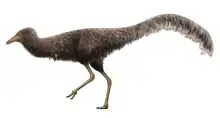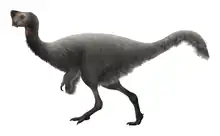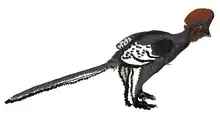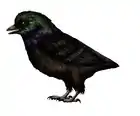| Castignovolucris Temporal range: Late Cretaceous, ~ | |
|---|---|
| Scientific classification | |
| Domain: | Eukaryota |
| Kingdom: | Animalia |
| Phylum: | Chordata |
| Clade: | Dinosauria |
| Clade: | Saurischia |
| Clade: | Theropoda |
| Clade: | Avialae |
| Clade: | †Enantiornithes |
| Genus: | †Castignovolucris Buffetaut et al., 2023 |
| Species: | †C. sebei |
| Binomial name | |
| †Castignovolucris sebei Buffetaut et al., 2023 | |
Castignovolucris (meaning "Castigno valley bird") is an extinct genus of enantornithe bird from the Late Cretaceous "continental red clays" of the Argiles et Grès à Reptiles Formation of France. It contains a single species, C. sebei, which was named and described in 2023.[1]
Discovery and naming
The holotype, MC-VCZ2-6, a right coracoid, was discovered near Villespassans by Stéphane Sèbe and was donated to the Musée de Cruzy.
Castignovolucris sebei was named and described by Buffetaut et al. (2023).[1]
Description
Castignovolucris was estimated to have a wingspan of around 127–185 cm (50–73 in) and may have been 75 to 110 cm (30 to 43 in) long when fully grown,[1] making it one of the largest known enantiornitheans to date.
Paleobiology
Castignovolucris would have been found on the Ibero-Armorican island in what is today Occitania, France.[2]
References
- 1 2 3 Buffetaut, E.; Angst, D.; Tong, H. (2023). "A new enantiornithine bird from Upper Cretaceous non-marine deposits at Villespassans (Hérault, southern France)". Annales de Paléontologie. 109 (1). 102585. Bibcode:2023AnPal.10902585B. doi:10.1016/j.annpal.2022.102585. S2CID 257863645.
- ↑ Csiki-Sava, Zoltan; Buffetaut, Eric; Ősi, Attila; Pereda-Suberbiola, Xabier; Brusatte, Stephen L. (2015-01-08). "Island life in the Cretaceous - faunal composition, biogeography, evolution, and extinction of land-living vertebrates on the Late Cretaceous European archipelago". ZooKeys (469): 1–161. Bibcode:2015ZooK..469....1C. doi:10.3897/zookeys.469.8439. ISSN 1313-2970. PMC 4296572. PMID 25610343.








.png.webp)


.jpg.webp)




